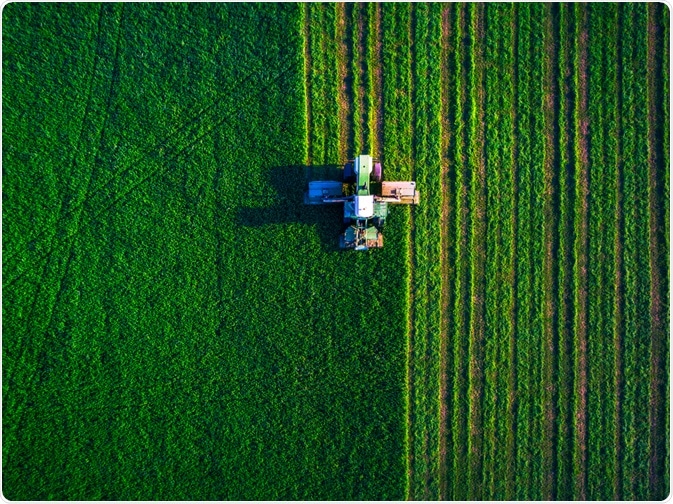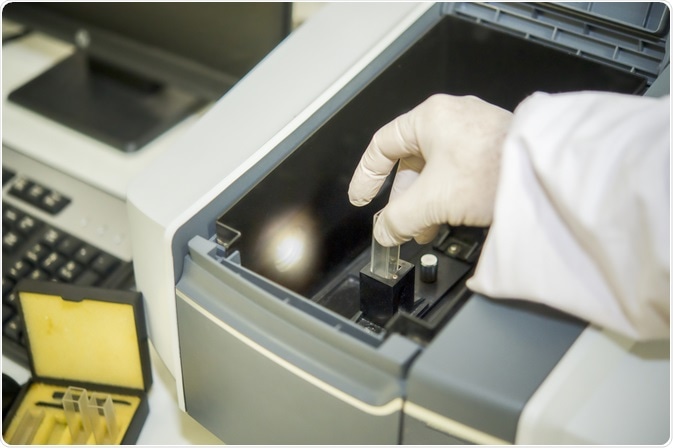As light passes through a sample, part of the radiation is absorbed. Spectroscopy measures how light interacts with molecules and provides information about the sample. It is commonly used in several fields, from pharmaceutical research to material science and agriculture.

Image Credit: Valentin Valkov/Shutterstock.com
Depending on the wavelength of the light used, different properties of an object can be observed and several techniques have been developed. The most common types of spectroscopy used in agriculture are:
- Near-infrared (NIR) spectroscopy
- Ultraviolet-Visible (UV-Vis) spectroscopy
- Nuclear Magnetic Resonance (NMR) spectroscopy
- Atomic Absorption (AA) and Atomic Emission (AE) spectroscopy
NIR spectroscopy in agriculture
NIR spectroscopy operates with wavelengths ranging from 780 nm to 2500 nm. The technique measures the absorbance of radiation of the molecular vibrational frequencies for characteristic organic functional groups, such as O-H, N-H, C-C, C-O, and N-O.
NIR spectroscopy is easy, fast, non-destructive, and inexpensive, and allows for quality assessments with no or little previous sample preparation. It can find applications in agriculture for the quality analysis of fruits and vegetables at the industrial or semi-industrial level.
Ongoing research is currently focused on improving the efficiency of the technique for product analysis in situ. While products are conventionally analyzed in a lab away from the production site, NIR spectroscopy enables in-line monitoring of products, providing more accurate information about postharvest handling of fruits and vegetables.
One example is the in-line analysis of intact apples to detect moldy cores by using a VIS-NIR mini-spectrometer (400–1000 nm). The analysis resulted in the successful identification of healthy apples, with a 100% accuracy in cases where the deterioration was above 30%.
UV-Vis spectroscopy for internal constituents of agri-food products and soil analysis
UV-Vis spectroscopy uses wavelengths in the region of 100 – 380 nm (UV) and 380 – 750 nm (Vis) and can be used to identify organic molecules in a variety of agricultural products, such as pigments in apples and the presence of contaminants in eggs.
Measurements between 590 and 700 nm can be used to monitor the maturity at the early stages of yellow apples, while the reflectance (the intensity of light reflected from a sample) at 678 nm is suggested for the measurements of the pigment content.
Another application of UV-Vis spectroscopy in agriculture is the determination of fertilizers’ components, such as nitrates and phosphates, in soil samples. Although useful for promoting crop growth, fertilizers must be closely monitored to ensure that the proper nutrient contents are supplied to the soil.

Image Credit: Rabbitmindphoto/Shutterstock.com
HRMAS NMR spectroscopy to monitor organic contaminants
NMR spectroscopy is a powerful tool for the identification of complex chemical compounds. The technique measures the radiation emitted by some nuclei when a magnetic field is applied.
However, commonly used liquid-state NMR spectroscopy presents some challenges in the molecular identification of agricultural matrices (plant roots, leaves, soils, etc.) since it requires preliminary sample preparation. Operations such as extraction, purification, and concentration, not only are time-consuming but can also lead to loss and/or degradation of the sample components.
High-resolution magic angle spinning (HRMAS) NMR enables the direct application to semi-solid and gel-like samples and has been successfully applied to study the effects of inorganic and organic contaminants in biological tissues.
HRMAS NMR was used to study the influence of arsenic-contaminated irrigation water on lettuce (Lactuca sativa L.) and to verify how fresh lettuce leaves were affected by the arsenic uptake, proving to be an excellent candidate to assess the general quality of agri-food products.
LIBS for multi-elemental analysis of soils
Laser-induced breakdown spectroscopy (LIBS) is an emerging atomic spectroscopy technique that can detect every element in the periodic table, it requires almost no sample preparation and can be used in agriculture for the multi-elemental analysis of soils.
A pulse from a high-power laser generates a high-temperature micro-plasma on the sample surface, exciting the electrons of the sample’s atoms and ions. As the plasma cools down it emits light with discrete spectral peaks which are characteristic of the elemental components of the sample.
LIBS can therefore provide important information on soil composition and has been used to characterize the total elemental concentrations, as well as the concentrations of soil nutrients (i.e. Mg, Ca, K, N, and P), but also to determine the extent of contamination by toxic metals (i.e. Pb, Cd and As) in soils.
Further research is underway aiming to expand the scope of LIBS to other agricultural applications, such as the determination of the Cation Exchange Capacity (CEC), which describes the efficiency of soils to hold and transfer nutrients at the soil-root interface.
Despite LIBS is a simple, convenient, and versatile technique, there are some limitations to take into account, such as the fluctuation of the emission lines intensity due to the non-homogeneous surface of the samples and the need of calibration.
This emerging technique requires more field studies and validation with different types of soils, to exploit the full potential for in situ applications in agriculture.
There are still several aspects that require optimization to make spectroscopy widely applicable in agriculture on the industrial or semi-industrial level. However, techniques that a few years ago seemed to be limited only to research lab environments, are today promising alternatives for real-life, in situ applications.
References
- Cortés, V., Blasco, J., Aleixos, N., Cubero, S. & Talens, P. (2019). Monitoring strategies for quality control of agricultural products using visible and near-infrared spectroscopy: A review. Trends in Food Science & Technology, 85, 138-148.10.1016/j.tifs.2019.01.015
- Mazzei, P. & Piccolo, A. (2017). HRMAS NMR spectroscopy applications in agriculture. Chemical and Biological Technologies in Agriculture, 4.10.1186/s40538-017-0093-9
- Pelagio, M. C., Navarro, D. A., Janik, L. J. & Lamorena, R. B. (2020). Potential Application of Laser‐Induced Breakdown Spectroscopy (LIBS) Data for the Determination of Cation Exchange Capacity (CEC) of Agricultural Soils. ChemistrySelect, 5, 3798-3804.10.1002/slct.202000107
- Yeong, T. J., Pin Jern, K., Yao, L. K., Hannan, M. A. & Hoon, S. T. G. (2019). Applications of Photonics in Agriculture Sector: A Review. Molecules, 24.10.3390/molecules24102025
Last Updated: Sep 7, 2020